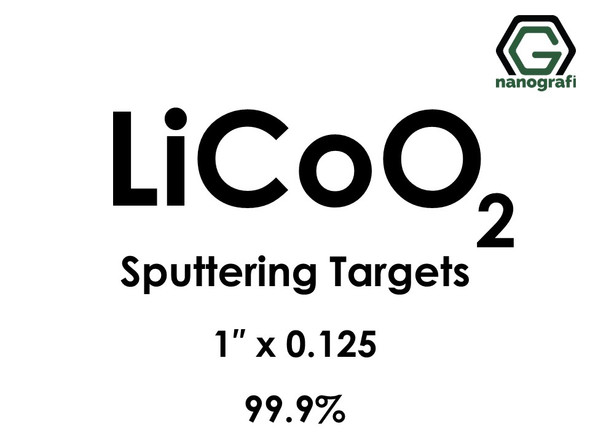Description
1 piece/608 €
Please contact us for quotes on larger quantities !!!
Lithium Cobalt Oxide (LiCoO2) Sputtering Targets
Purity: 99.9%, Size: 3'', Thickness: 0.125''
Sputtering is a proven technology capable of depositing thin films from a wide variety of materials on to diverse substrate shapes and sizes.
The process with sputter targets is repeatable and can be scaled up from small research and development projects. The proses with sputter
targets can be adapted to the production batches involving medium to large substrate areas. The chemical reaction can occur on the target
surface, in-flight or on the substrate depending on the process parameters. The many parameters make sputter deposition a complex process
but allow experts a large degree of control over the growth and microstructure of the area.
Applications of Sputtering Targets;
- Sputtering targets is used for film deposition. The deposition made by sputter targets is a method of depositing thin films by sputtering
that involves eroding material from a "target" source onto a "substrate" such as a silicon wafer. - Semiconductor sputtering targets is used to etch the target. Sputter etching is chosen in cases where a high degree of etching anisotropy
is needed and selectivity is not a concern. - Sputter targets is also used for analysis by etching away the target material.
One of the example occurs in secondary ion spectroscopy (SIMS), where the target sample is sputtered at a constant rate. As the target is sputtered,
the concentration and identity of sputtered atoms are measured using mass spectrometry. By helping of the sputtering target, the composition of the
target material can be determined and even extremely low concentrations of impurities are detected.
Sputtering target has also application area in space. Sputtering is one of the forms of space weathering, a process that changes the physical and
chemical properties of airless bodies, such as asteroids and the Moon.
Lithium cobalt oxide is a chemical compound with formula LiCoO2. Lithium cobalt oxide is a dark blue or bluish-gray crystalline solid and is commonly
used in the positive electrodes of lithium-ion batteries.
Now let's see how lithium cobalt oxide sputtering targets can be used in batteries. Batteries with very small sizes are of immense interest, as the sizes
of portable microelectronic devices and sensors decrease continuously. Thin film batteries can be used as power sources for various low power electronic
devices such as portable electronic devices and micro electro mechanical systems (MEMS) which require very low power and current levels and hence can
be powered by thin film batteries.
In battery applications magnetron sputter system can used used. The required thin film lithium can be generally deposited by conventional sputtering target
techniques, whereby a LiCoO2 sputtering target assembly, defined as the LiCoO2sputtering target bonded to a backing plate, can be used to deposit the
required thin film lithium. With regards to sputtering targets to produce Li thin films, a D.C. (direct current) magnetron sputter system can be employed. The
LixCoyO2sputtering target is generally represented by the formula LiCoO2 and forms a part of a cathode assembly that, together with an anode, is placed in an
evacuated chamber filled with an inert gas, preferably argon. Magnets are disposed above the LiCoO2 sputtering target, and a switch for connecting target
backing plate to a D.C. voltage source. A substrate support is positioned below LiCoO2 sputter target within the chamber. In operation, a high voltage electrical
field is applied across the cathode and the anode. The inert gas is ionized by collision with electrons ejected from the cathode. Positively charged gas ions are
attracted to the cathode and, upon impingement with the target surface, these ions dislodge the target material. The dislodged target material traverses the
evacuated enclosure and deposits as a LiCoO2 thin film on the desired substrate, which is normally located close to the anode.






